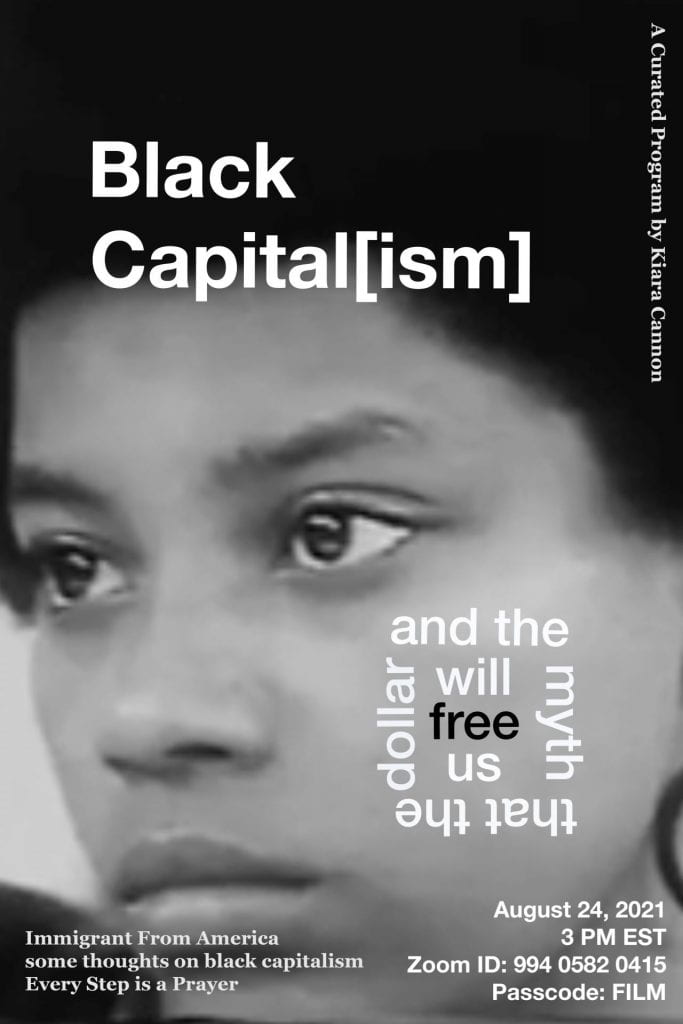Walls turned sideways are bridges
– Angela Davis
a moving image curation
by Kiara Cannon
Proposal
What is meant for us now as descendants of slaves; children born atop the capital of pain—physical, mental, psychological, and generational oppression.
We are the human capital. Yet we are told in the system handed to us that the only way to 1. survive and 2. be worthy is to accumulate wealth, resources and land that is NOT ours.
What does it mean for the descendants of African slaves— the original American transcontinental capital— to live within a society that equates success, prosperity and wealth with monetary gain?
Grounded in existentialism, the American descendants of African slaves structurally find themselves thrust into [and biopolitically dependent on] an American capitalist system that defines wealth as monetary and capital gain while structurally barring generations of those same descendants from accumulating wealth. This being the case, it leaves these descendants with many questions. What does the black individual strive for? What is the “American Dream” to the descendants of slaves? What is freedom in a socioeconomic system where it must be bought?
This given the structure, we must first assess where we find ourselves within the system imposed onto us. I want to empathetically inspect the phenomenological perspectives perpetuated within the bio-political structures of America and its legacy of slavery and black human capital. In understanding our positionality within that system, can we too—like our ancestors—escape? What does freedom look like and how can we realize it? How can our dreams and visions lead us to imagining a future built for and by us?
Gorgon Parks, American Gothic, US
Program Notes
The American descendants of African slaves find themselves within a precarious situation. Born unto the survivors of the over 12 million African peoples forcibly and transcontinentally displaced from Africa to the Americas as human capital, the black individual must ask themselves: What is freedom within a capitalist society?
This program intends to answer this question by inspecting 1. The complex positionality of the black individual as formerly enslaved human capital, 2. The requirements of freedom and survival within the American capitalist system and 3. The methodologies of dreaming, envisioning freedom and escaping bondage and exploitation.
In rejecting the capitalist structure that prioritizes the accumulation of land and resources for material profit, what can we learn from reconnecting to the land, sharing our liberative and anti-capitalist and anti-colonial methodologies, and promoting communal health and healing?
Runtime: 49 min 07 sec
Bill Buckley (Rediscovery Productions), 2011, US, 21:08
In a classroom exchange over students from various backgrounds retelling the and hardships of their family’s immigration to America, a teacher steps in to tell the story of black migration to the North American continent and the impediments in the way of their descendants’ American Dream.
Filmmaker Questions:
- What was the significance of the black teacher narrator being the one tasked with educating and having agency over historical narrative?
- As a white filmmaker, what was your intention in deconstructing the ‘American dream’ from various racial and ethnic conditions? Do you yourself believe in the American dream, and if so, do you believe it’s accessible to all?
some thoughts on black capitalism
xee matthews, 2020, US, 16:26
Over chill vibes and a makeup tutorial, Xee Matthews reflects on an experience of exploitation at the hands of an employer and uses it to deconstruct the structural relationship between wealth, freedom and the black American experience under racial capitalism.
Filmmaker Questions:
- How does art, makeup and video production allow you agency over your identity and future as it relates to and expands beyond your diasporic condition?
- Your commentary and videomaking process involves a lot of vulnerability: 1. Having to use your own experiences and positionality to analyze structural oppression and disenfranchisement—and as a black woman, majorly finding yourself the victim of those intersectional structures. 2. Showing your makeup process and serving looks while fighting against internalized and externally imposed notions of white and racialized, female beauty standards. As a filmmaker, how do you overcome these challenges and embrace vulnerability to further your art and praxis?
Cara Stricker, 2021, US, 8:33
In what is self-described as a “techno-surrealist journey to the Florida Everglades”, the imaginative, ‘internal’ world and physical land are visually united to depict a realm of safety, healing and communal prosperity for the descendants of black and indigenous peoples.
Filmmaker Questions:
- What was the significance of visually uniting a futuristic realm of prosperity for black and indigenous peoples with physical land and collective human movement? How does imagining and creating futures on the screen help you take agency within the present?
- While exploring the complex Afro-Indigenous significance of the Florida Everglades, it thematically parallels communal healing and care with loving and caring for the land that originally protected Indigenous and Maroon peoples. What are your methodologies for centering care and healing for the subject and land within your filmmaking practice?

